Spiders are remarkable creatures that inhabit all the continents of the world except Antarctica. . While the eight-legged crawlers can be found in homes, garages, barns and gardens, farms, forests, and jungles, they also thrive in hot dry deserts, cold deserts as well as swamps and marshes. Some spiders like taking the occasional ride in cars too, especially the huntsman spider.
But what do spiders eat? A spider’s diet depends on species and habitat. Their prey includes flies, cockroaches, mites, centipedes, millipedes, and spiders. Also, larger prey like frogs, toads, lizards, geckos, skinks, snakes, mice, and birds also form part of some spiders’ diet. Others eat plant matter and nectar.
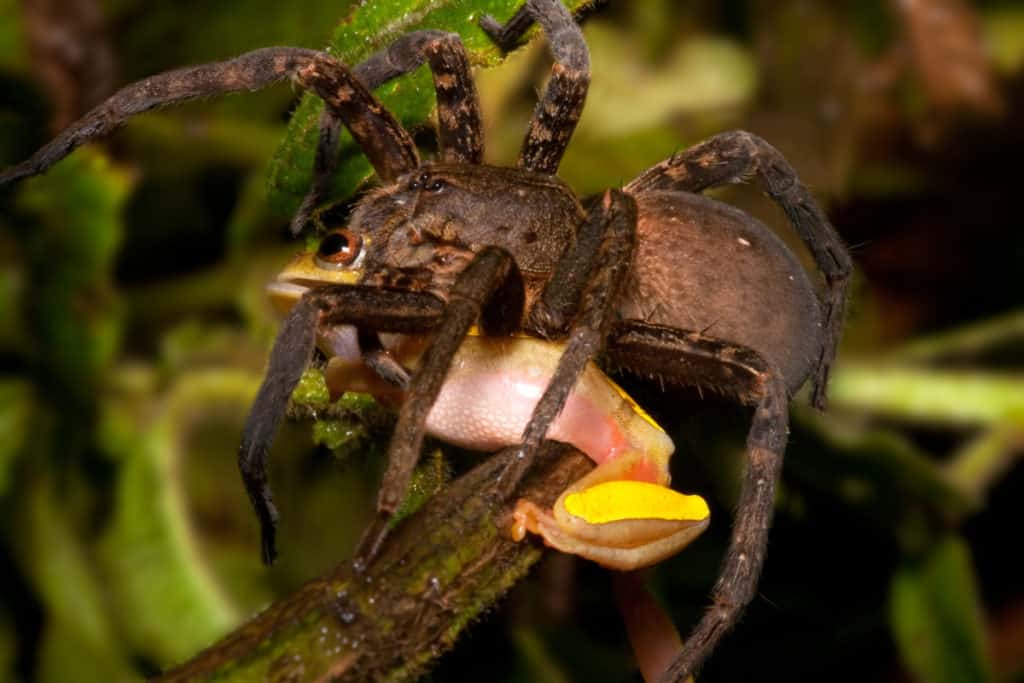
Read on to learn more about the spider’s diet.
Spider Groups
Generally speaking, spiders can be divided into two groups:
- Wandering or hunting spiders
- Web-building spiders.
Both groups belong to the Arthropoda species in the class Arachnids and bear similar anatomical characteristics. They have two body segments (tagmata), the front segment, a cephalothorax (prosoma), and the abdomen (opisthosoma). These two tagmata (body segments) are connected by a thin waist-like structure called a pedicel.
All spiders can create silk and use it in different methods and ways to capture prey. They can build orbs, spin webs, and layout draglines and tripwires, wrap eggs or create tunnels; some species also wrap their prey in webs and cover it with digestive juices that turn it into liquid and then suck it up into their stomach.
Since the majority of spiders feed on insects and other spiders, nature appears to have favored them by specifically arming them with spider venom made to be toxic to their victims. Their venom is important weapon spiders use to immobilize and kill their prey.
Read on as we take a deeper look at these two categories of spiders before we look at the diets of specific spider species.
Wandering Or Hunting Spiders
Most spiders are terrestrial, meaning land-dwelling. Wandering or hunting spiders, as the name suggests, range widely in search of prey. Many of these species live in burrows and hunt or run down and capture or trap their prey on the ground. Examples of these spiders are the Huntsman spider, the Tarantulas, and the Garden spiders.
They are equipped with many eyes and have good eyesight. Two of the four pairs of eyes are large anterior eyes located directly on top of the head just above the mouthparts (chelicerae). The mouthparts have powerful serrated fangs that are usually arranged up and down; the fangs are used to inject venom into captured prey.
They have thick and powerful hairy legs for jumping on or chasing and running down prey. Hunting spiders have modified feet that allow them to climb walls, run very quickly, and jump on prey. Their hairy legs have airy pads that improve traction and make web walking easy.
Spiders that live in burrows rig up tripwires using strands of web. The vibrations that result when prey triggers the strands alert the spider which then comes out to investigate and capture the unfortunate victim.
Web Building Spiders
Web-building spiders spin their webs; the design of the web is adept at trapping prey. These spiders are agile and patiently wait for prey to get trapped on their webs. They don’t chase prey since they cannot rely on their poor eyesight or thin hairy legs which are better adapted for hanging on web strands.
The legs have three hooks that allow web-building spiders to maneuver efficiently on webs. They have many tiny eyes, all with poor eyesight. Their chelicerae have weak jaws with fangs more horizontal and are usually not serrated. Venom is delivered through their hollow pointy fangs.
Web-building spiders can also become prey on their own webs from a genus of some very smart jumping species. Portia is a genus of jumping spiders that is a most excellent and intelligent specialist in this strategy as we shall see further down in this post.
How Do Spiders Consume Their Prey?
Spiders have mouthparts known as chelicerae, also commonly referred to as “jaws”. They are the only appendages that are in front of the mouth. Chelicerae are connected to the venom glands which are located in the prosoma. They are used to inject venom into prey or a perceived threat.
The shapes of chelicerae can be either articulated fangs with an up and down function or can be shaped like pincers. They are used to hold the prey as the spider covers it with digestive juices. Spiders don’t have true teeth and can’t chew; they can only suck up or drink semisolid or mashed food through their straw-like mouth.
Spiders use their chelicerae to tenderize their prey by covering the victim with digestive enzymes that turn it into liquid. Most spider species partially digest their prey as it is held in their chelicerae. Some spiders in the hunting family have strong chelicerae that can hold down prey on a firm surface as they begin the digestion process outside of the spider’s body.
Other spiders, (web-spinning) with weaker chelicerae spew digestive enzymes onto the trapped prey to start the process that takes a few seconds. Once the prey is liquefied, the spider proceeds to feed by sucking up the mashed food.
Diet And Hunting Behavior By Type Of Spider
Let’s now look at some particular species and explore deeper into their specific diets and hunting behavior.
Eating Habits Of Tarantulas (Theraphosidae family)
What Do Tarantula Spiders Eat? Well, Tarantulas mainly eat insects which make the biggest part of their diet. However, they also prey on bigger game, including frogs, toads and mice, and small snakes.
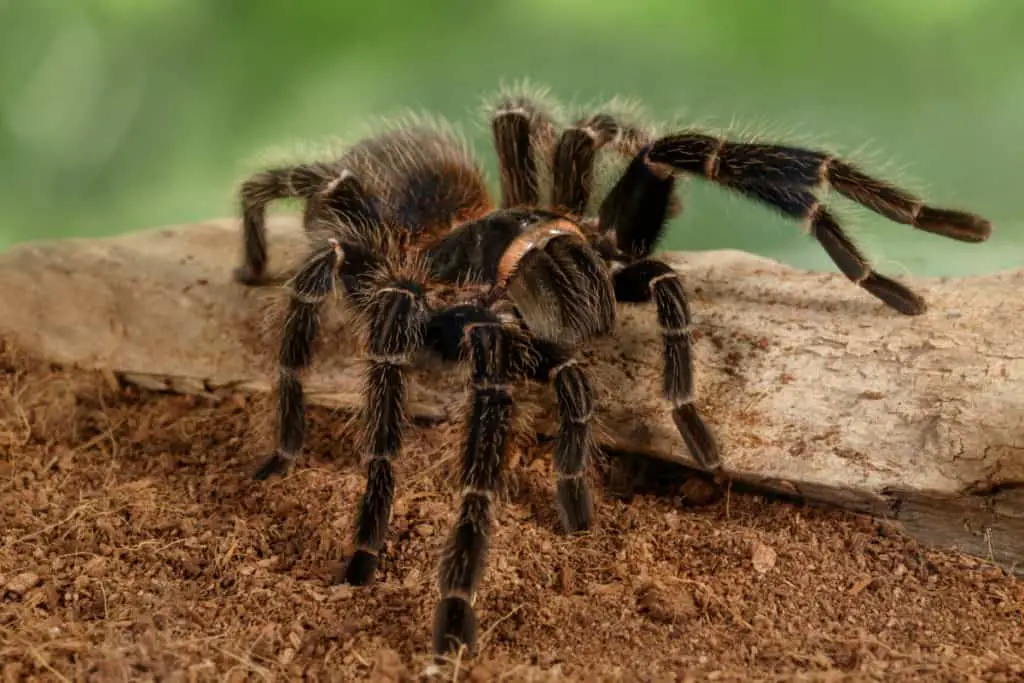
The largest of all tarantula species is the Goliath bird eater (Theraphosa Blondi), found in Brazil and Venezuela and has been reported to weigh up to 170 grams or 6 Ounces. It can have a whooping leg span of up to 30 centimeters or 12 inches. This tarantula has a fang size that can reach up to a maximum of 3.8cm or 1.5 inches.
Despite its grotesque name, the Goliath bird eater spider is an opportunistic predator that rarely actually preys on birds. Its diet primarily consists of other large arthropods, worms, and amphibians; this includes rodents, frogs, toads, lizards, and even small snakes.
How Do Tarantulas Capture Their Prey?
Tarantulas move slowly and deliberately. They are accomplished and relentless nocturnal predators. A tarantula does not use a web to ensnare prey. It is one of the species that may spin trip wires to trigger an alert when something approaches it’s a burrow.
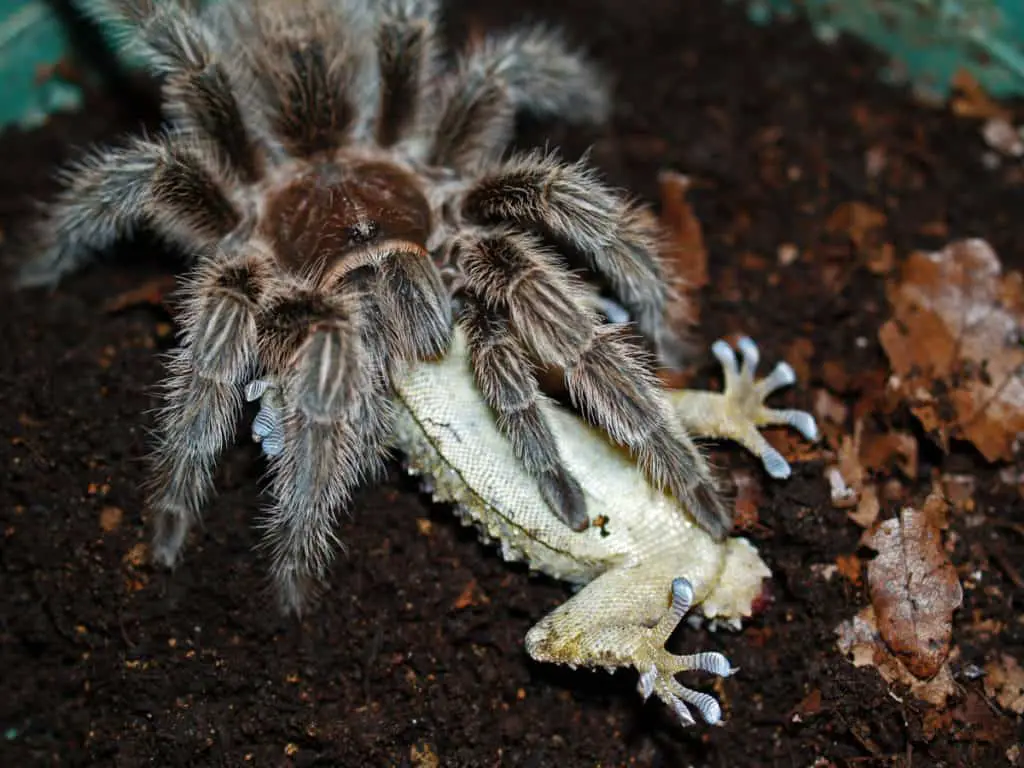
These spiders have powerful chelicerae with which they grab their prey, injecting paralyzing venom. They subdue and dispatch their victims with the venomous bite.
How Do Tarantulas Eat Their Prey?
Once they have subdued their prey, tarantulas secrete digestive enzymes to liquefy their victims’ bodies in order to suck them up through their straw-like mouth openings. Their abdomens can expand quite a bit, and after a large meal, the tarantula may not need to eat for up to one month.
Do Tarantulas Eat Their Prey Right Away Or Eat Them Later?
After capturing their prey, tarantulas drag it back to the burrow to consume it. They do not eat their prey out in the open. In the privacy and safety of their burrow, they liquefy the prey and proceed to suck it dry. Goliath bird eaters can live anywhere from 15 to 20 years in the wild.
Eating Habits Of Huntsman Spiders (Sparassidae Family)
As the name suggests, huntsman spiders are hunters. Because of their size and appearance, they are also called giant crab spiders. The name derives from their unusual leg arrangement – they sit away from the body giving a cab-like appearance, which explains their alternative name.
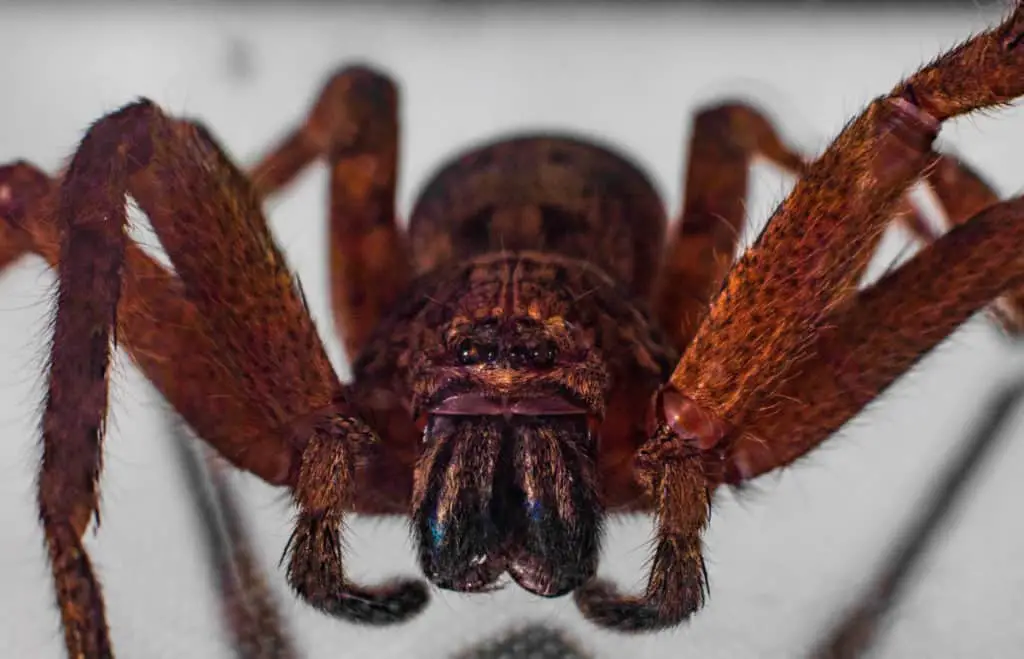
They can be found in forests, woodpiles, mine shafts, and wooden shacks. The species is known to sneak its way into cars or houses and greenhouses when it gets too cold outside. But despite their size, they are fairly harmless and will scurry away from humans. But that is not to say they can’t bite. They exhibit a “cling” reflex reaction which makes them difficult to shake off, so it is not a good idea to pick them up.
What Do Huntsman Spiders Eat?
Huntsman spiders eat insects mostly. They hunt down cockroaches, small skinks, and geckos, as well as worms, centipedes, and millipedes are all part of the huntsman’s diet in the wild. Huntsman and similar spiders are highly valued in tropical countries because they keep cockroaches and other domestic pests in check by capturing and eating them.
We have actually written an entire article on spiders that eat roaches, the huntsman is one of them. If you are interested in what other also eat roaches check out the article, Do Spiders Eat Roaches?
How Do Huntsman Spiders Capture Their Prey?
Huntsman spiders use venom to immobilize and subdue their prey. They are nocturnal spiders and are extremely fast and efficient hunters. Speed is their real asset and some of the fastest huntsmen can cover up to 5 meters per second. This applies to some of the biggest spiders in this family.
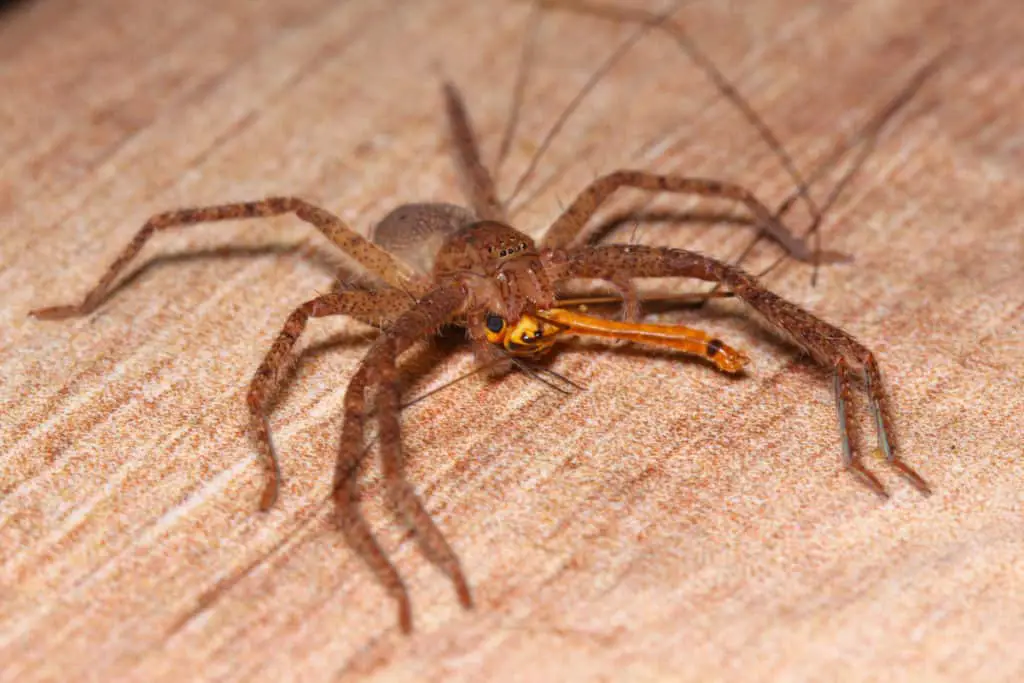
One of these is found in Laos and has a leg span of 30 centimeters. The huntsman spiders often use a springing jump while running, and they can walk on walls and even on ceilings. Their flattened body enables this large spider to squeeze through surprisingly small cracks and crevices.
Its ability to adapt to human habitations, along with its flattened body, helps explain its frequent occurrence in houses, barns, sheds, under boards on the ground, and in other sheltered areas. One unique species is the exception in the huntsman spider family since it is nonvenomous.
They are known as cribellate weavers or hackled orb weavers.
So how do they subdue their prey? Well, they have evolved a specialized trait where they wrap their prey thoroughly in silk, spew or regurgitate digestive enzymes on it, and then digest the liquefied body and proceed to suck up the food. They do not use venom to immobilize prey.
A cribellate is feathery, fuzzy silk (hackled silk). It is produced by all members of the Uloboboridae family. This orb often has a zigzag pattern through the center whose function is not yet fully understood.
How Do Huntsman Spiders Eat Their Prey?
Huntsman spiders, being nocturnal, consume their prey mostly under the cover of darkness and not in public. They suck the liquefied prey into their stomach through their straw-like mouths after tenderizing it with digestive enzymes.
Do Huntsman Spiders Eat Their Prey Right Away Or Eat Them Later?
Most of the huntsman spiders eat their prey right away. However, the non-venomous orb-weaver may delay consuming its silk-wrapped victim for later.
Eating Habits Of Jumping Spiders (Salticidae Family)
Jumping Spiders makeup at least 13% of all species and are the largest family. This family of spiders has over 6000 described species.
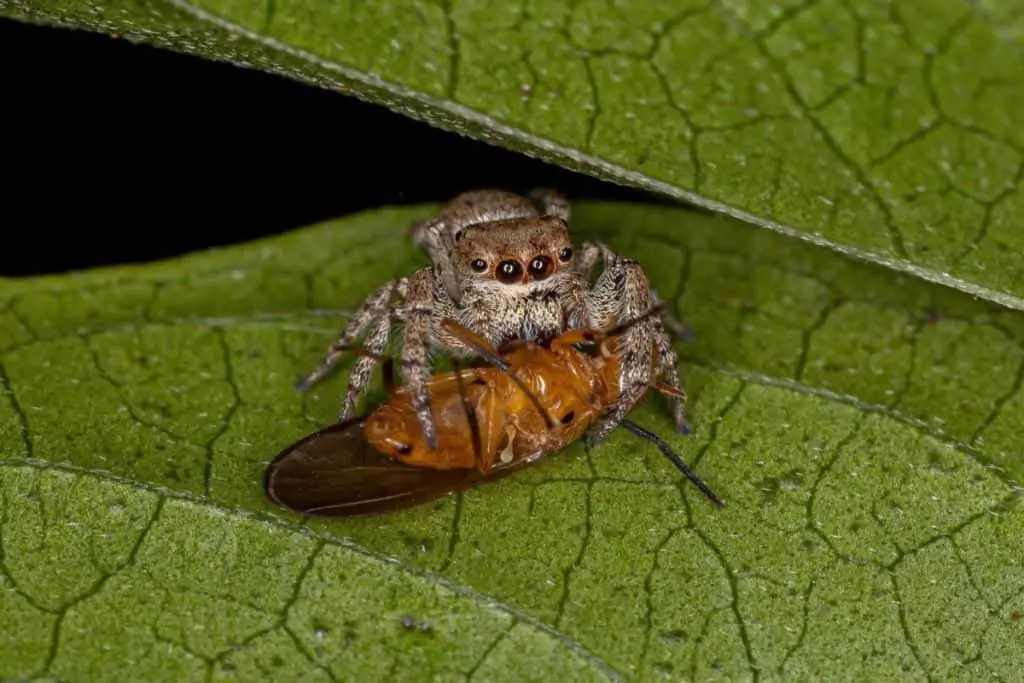
These spiders are relatively small. Their small size however is no hindrance to their ability to tackle prey far bigger than themselves. Examples of this genus are:
- Portia labiate
- Bagheera Kiplingi
- Portia fimbriata
- Portia schultzi
What Do Jumping Spiders Eat?
Jumping spiders eat flies, insects, and other spiders (they are Araneophagic or Arachnophagic) that fall for the numerous intelligent tactics and hunting strategies applied by jumping spiders.
But guess what? There is one genus of these species that is herbivorous, it is known as Bagheera Kiplingi.
Read on and find out more about this novelty.
Bagheera Kiplingi Spiders
This genus of jumping spiders is found in Central America and is spread in Mexico, Costa Rica, and Guatemala. They have one of the most peculiar diets among all known spider species.
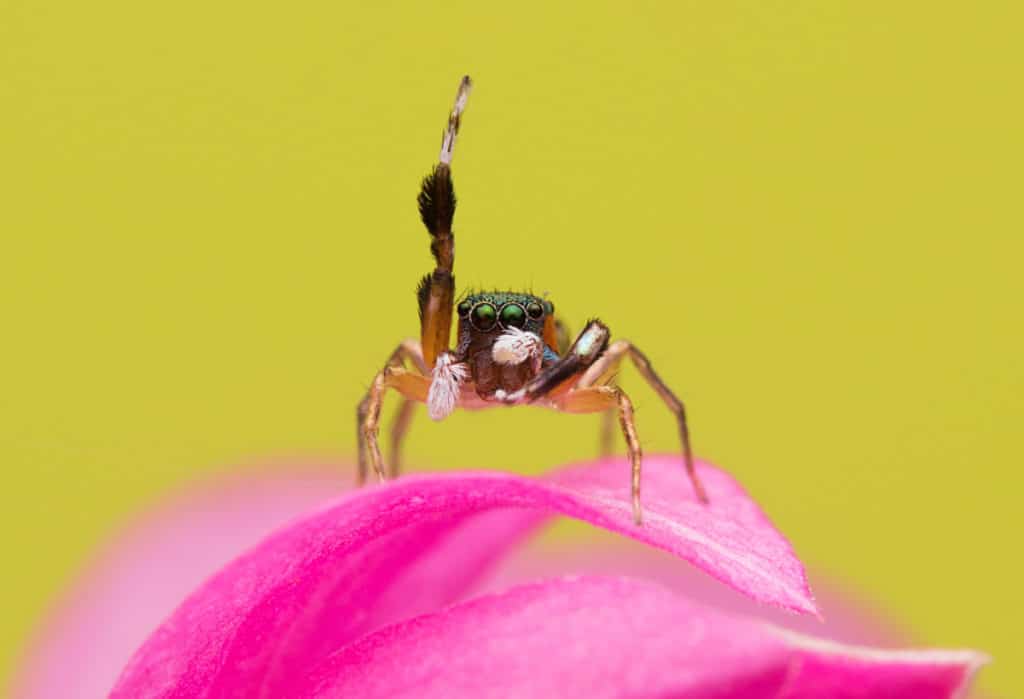
They feed to a large extent on plant material (are herbivorous). They are also known to feed on nectar from plants such as partridge peas. Their favorite food source is Betian Bodies. This is a detachable tip found on the pinnules of some species of Acacia and closely related genera.
This food source, often red in color, is rich in lipids, sugars, and proteins. Bagheera Kiplingi’s diet is almost exclusively Betian Bodies. No chasing prey or messy eating habits for these spiders!
How Do Jumping Spiders Capture Their Prey?
Jumping spiders are able to trap spiders between 10% and 200% of their own size. Web-building spiders are a favorite part of jumping spiders’ diet. Jumping spiders have some of the best vision among arthropods and put it to good use in hunting, navigation, and courtship.
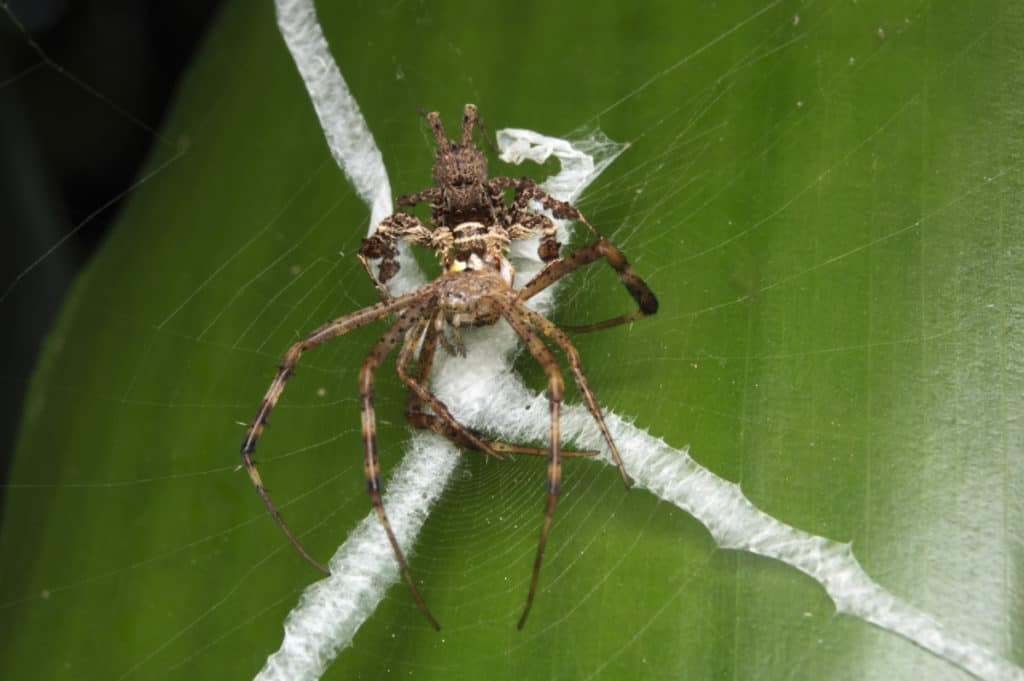
While hunting, all members of Portia have instinctive behavior for their most common prey. But should they encounter unfamiliar prey or unfamiliar situations, they can improvise through trial-and-error, and then remember or devise a new attack approach.
Sometimes this can lead to changing attack angles or routes as well as abseiling down a silk thread to bite the prey from behind.
Hunting Strategies Of The Portia Jumping Spiders
These spiders have an appearance like leaf litter caught in a web. Web building spiders have poor eyesight and are often fooled by what to them looks like leaf debris caught in a web.
Portia exhibits intelligent hunting techniques.
They mimic, with uncanny accuracy, the different patterns of vibrations in the web. They do this aggressively enough to trick or induce the intended prey to move towards the Portia. These vibrations are similar to those made by the struggles of a trapped insect or the courtship of a male spider.
The species Portia Fimbriata has been observed to persist in performing vibratory behavior for three days. The result is that the victim decides to investigate, and its fate is sealed. When light breezes blow, it’s time for Portia to invade the webs because the vibrations that they cause as they approach are blurred by the breeze.
The potential prey cannot discern or isolate the vibrations made by the Portia! Rather than face a belligerent intended victim, the Portia backs off and will readily use long detours that break visual contact. Studies under laboratory conditions revealed that Portia learns very quickly how to overcome web-building spiders that it would not have naturally met out in the wild.
They exhibit a trial-and-error approach from which they learn very quickly, aided by their very accurate visual recognition of potential prey. This is an important part of their hunting strategy.
In their arsenal of hunting tactics, Portia applies different methods against different prey. When attacking prey such as flies, which are unarmed, they simply stalk and rush in; they also use sticky webs as a means of capturing prey.
In one part of the Philippines, for example, the very dangerous spitting spiders can be found. These spiders also hunt jumping spiders. Local Portia spiders attack them from the rear in what appears to be instinctive behavior. If a Portia makes a mistake while hunting another spider, it may pay with its life.
Movement by prey can also provide cues for Portia to locate and detect potential victims. When potential prey knows it’s been seen and stands still to avoid detection, Portia applies the strategy of undirected leaps in the vicinity of the prey. Believing itself to have been seen, the prey will then react to this visual cue.
Its reaction will provide motion that is its undoing; it allows the Portia to move in and attack. Portia is also not averse to scavenging corpses of dead arthropods they find.
Another fascinating bug that scavenged dead arthropods and will even feed on rotting animal corpses is a bee. That right a very special bee called a vulture bee. If you are interested we have an entire article about our investigations, its called, Vulture Bees: There Are Meat Eating Bees And They Make Honey
How Do Jumping Spiders Eat Their Prey?
Apart from the herbivorous Bagheera Kiplingi, other jumping spiders eat their prey by liquefying and sucking up the victims.
Do Jumping Spiders Eat Their Prey Right Away Or Eat Them Later?
More often than not, jumping spiders eat their prey right away. However, if numerous prey becomes trapped on the web then they are in no big hurry to feast. The prey can be eaten later.
The diets of jumping spiders is such an interesting topic that we have written an article dedicated to it. If you want to check it out the article is called, What Do Jumping Spiders Eat?
The Eating Habits of Daddy Longlegs Spiders (Pholcidae family)
Daddy longlegs is the common name given to the pholcids family. This may refer to Opilions, Phocidae, and crane fly. Harvestman, harvesters, or daddy longlegs are all in the Opilions order of arachnids. Pholcids are individual species of the family Pholcidae and include those commonly referred to as the following;
- Marbled cellar spider
- Daddy Long-leg spider
- Grand daddy long-legs spider
- Carpenter spider
- Vibrating spider
- Long daddy
- Skull spider
What Do Daddy Long-legs Spiders Eat?
Many species eat small insects and diverse plant material and yeasts and mold (fungi). A few have also been known to prey on amphibians. Some feed on dead organisms, bird droppings, and other excrements.
How Do Daddy Long-legs Spiders Capture Their Prey?
Pholcids (collective name for Daddy Long-legs) spin webs with an irregular structure to trap prey. The web has no adhesive properties.
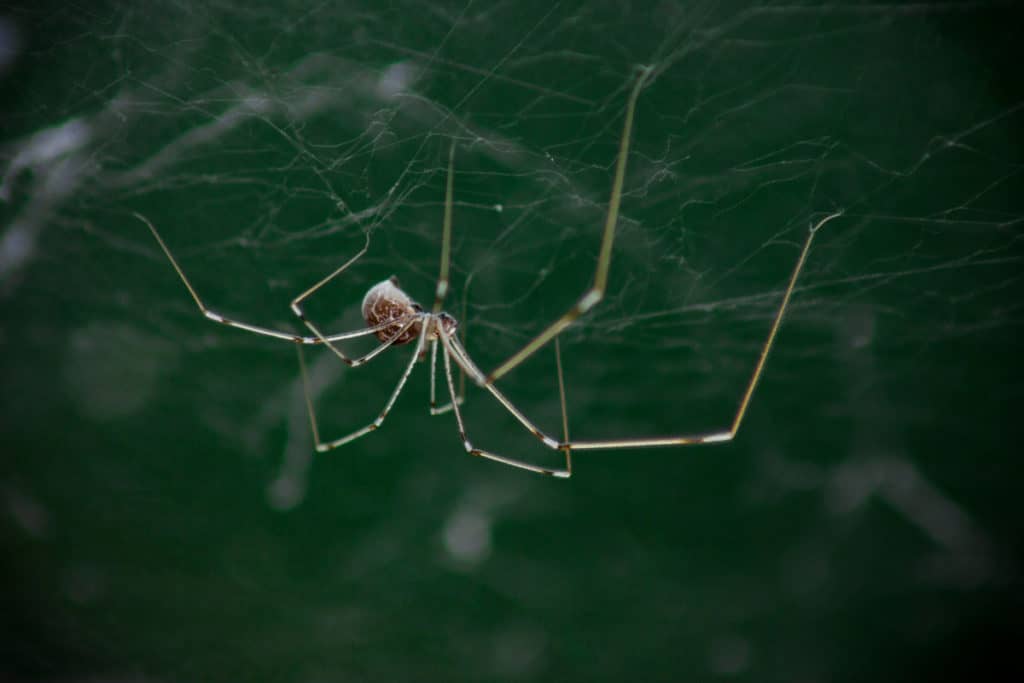
When pholcid spiders detect prey within their webs, the spiders move with speed to envelop the prey with a silk-like material before biting and injecting venom to kill the victim.
How Do Daddy Long-legs Eat Their Prey?
Daddy long-legs eat their prey by ingesting small particles of their food which exposes them to infestation by internal parasites.
Unlike most other spider species, daddy-long-legs (also known as harvestman) do not have a sucking stomach or filtering mechanism.
Do Daddy Long-legs Spiders Eat Their Prey Right Away Or Eat Them Later?
The prey may be eaten immediately or stored to be eaten later. When finished feeding they will do some housekeeping and clean the web by unhooking the remains of the prey. The carcass is let to drop from the web.
The Eating Habits Of Black Widow Spiders (Theridiidae family)
These small species vary widely in body size. They are found in temperate regions around the world. They derive their name from the macabre behavior of the female which sometimes kills and consumes their counterparts after mating.
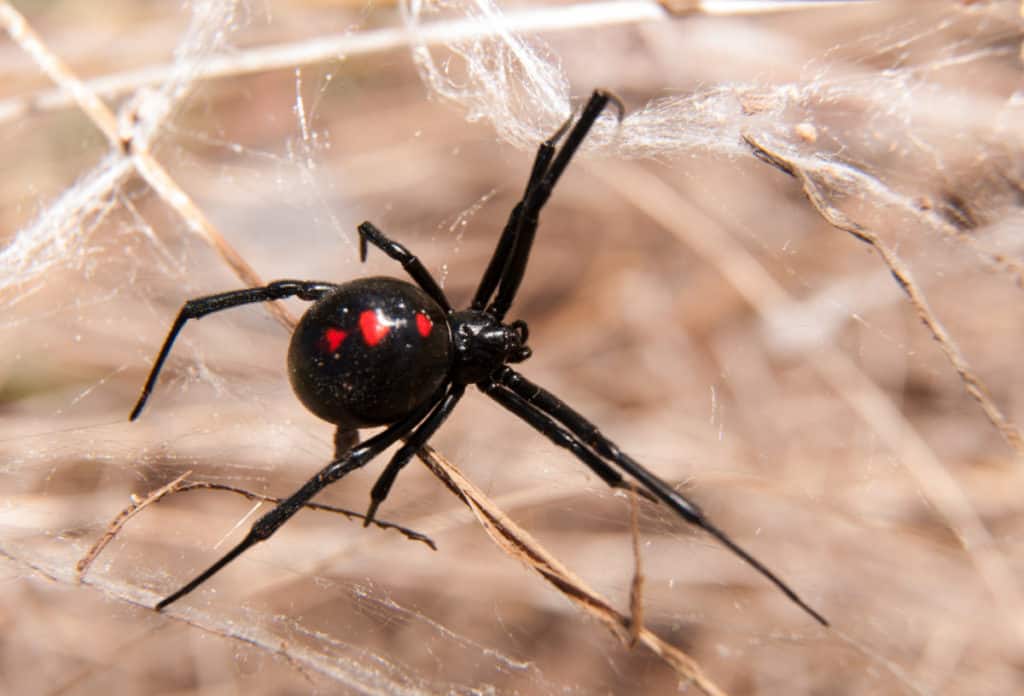
How Do Black Widow Spiders Eat?
These spiders feed on their prey after biting and injecting digestive juices into their insect victims with their serrated fangs. The enzymes liquefy the preys’ body and the spiders suck up the slurry.
How Do Black Widow Spiders Capture Their Prey?
These spiders spin large webs to ensnare their prey. Black widow spiders construct a web of irregular, tangled, sticky silken fibers. The spider then frequently hangs upside down at the center of its web and patiently waits for Insects to blunder in and get ensnared.
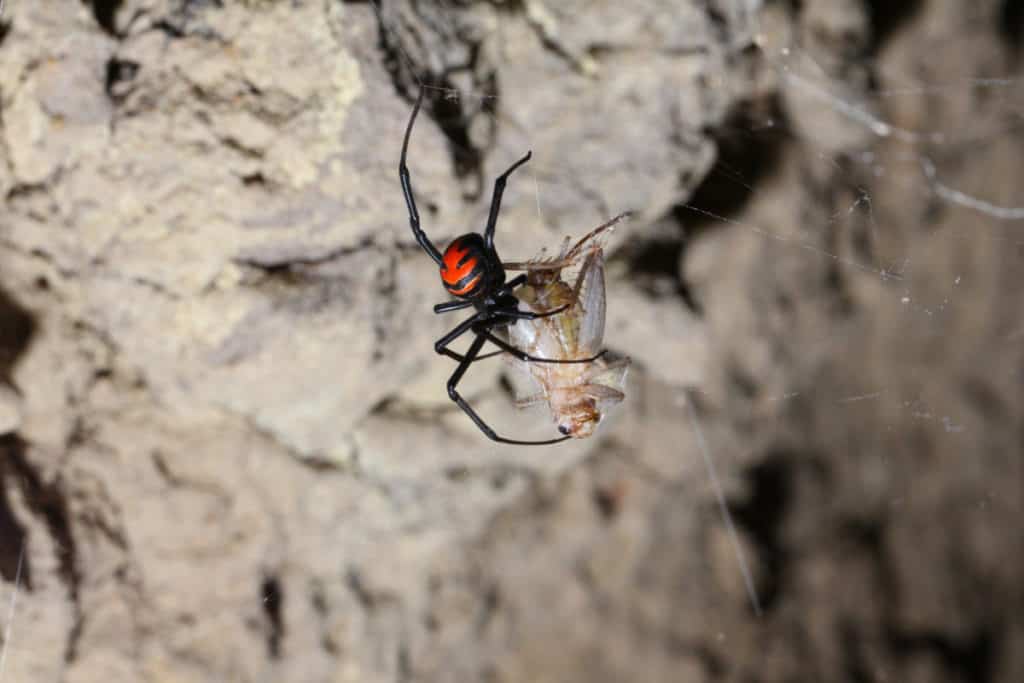
Before the insect can struggle free to escape, the spider rushes over to inject venom and wrap it in silk. As with other web weavers, these spiders depend on vibrations reaching through their webs to find trapped prey or warn them of other impending perils. They have very poor eyesight.
What Do Black Widow Spiders Eat?
Their prey consists of small insects such as flies, mosquitoes, grasshoppers, beetles, centipedes, and millipedes.
Do Black Widow Spiders Eat Their Prey Right Away Or Eat Them Later?
These spiders can eat some of the prey immediately but can also eat others that are trapped in the net later.
The Eating Habits Of Garden Spiders (Araneidae family)
These spiders are common in Hawaii, southern Canada, Mexico, and Central America. They have several common names;
- Black-and-yellow argiope
- Black-and-yellow garden spider
- Corn spider
- Golden garden spider
- Golden-orb weaver
- Writing spider
- Yellow garden argiope
- Yellow garden orb weaver
- Zipper spider
What Do Garden Spiders Eat?
Garden Spiders prey on small vertebrates such as geckos, green anoles, and insects.
How Do Garden Spiders Capture Their Prey?
These spiders spin webs that are usually characterized by a zigzag-shaped extra thick line of silk in the middle that extends vertically. The zigzag structure is called stablementum.
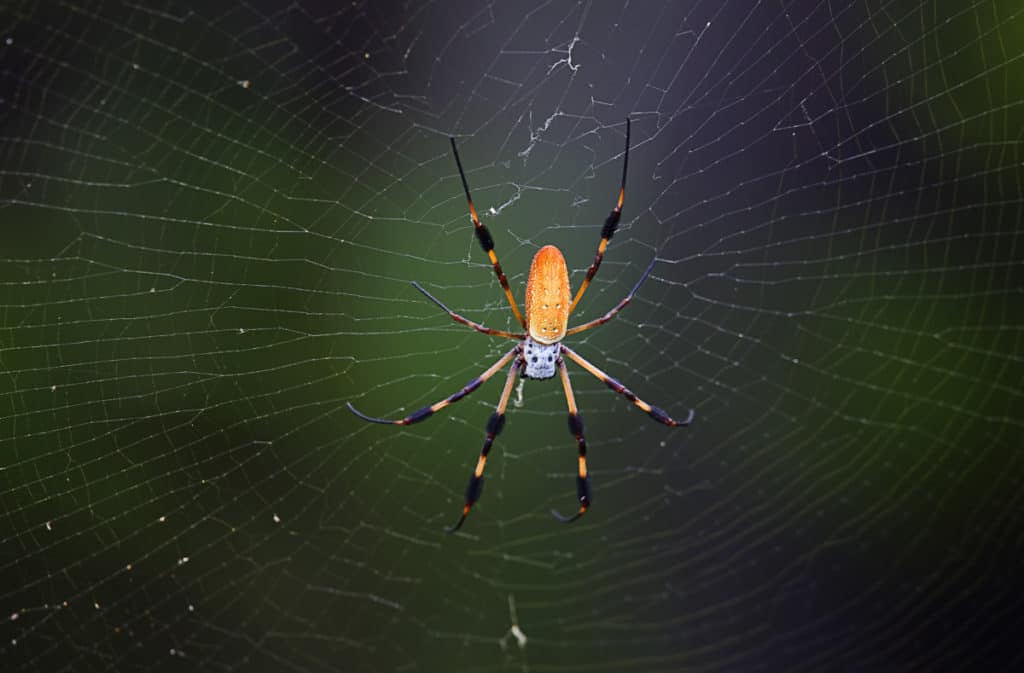
They wait patiently for prey to get trapped in the webs. When prey gets caught in the web, the spider may swing the web back and forth to further entangle the insect. When the prey is securely ensnared, the spider kills it by injecting venom and then wraps the victim in a cocoon of silk.
How Do Garden Spiders Eat Their Prey?
These spiders inject digestive enzymes into their prey and suck up the liquefied body.
Do the Garden Spiders Eat Their Prey Right Away Or Eat Them Later?
Garden spiders eat their prey later after wrapping it in a silken cocoon. Typically, the prey is eaten 1-4 hours later.
How Often Do Spiders Eat?
The frequency of spiders’ feeding may depend on the availability of prey or the spider’s rate of metabolism. Also, the size of the last meal eaten can determine when the spider will need to eat next. After a big meal, a tarantula, for example, can go for up to one month before eating again.
The Spider’s abdomen can expand considerably, hence when it feeds it can consume quite a heavy meal and may go for a while, depending on species, without eating.
We have an entire article about how long spiders can live without eating food. Check it out if you are interested, How Long Can Spiders Live Without Food?
The Wrap Up
Spider’s main source of food is insects, invertebrates, arthropods, and rodents. Spiders are well adapted to the different environments of their habitats around the world. For the most part, they don’t bother with humans, but rather mind their own business of hunting, trapping prey, and breeding.
They employ varying strategies in capturing prey, web building, and orb-weaving and burrowing from species to species. Some species in the tropics are valued for their natural domestic pests control role. They eat cockroaches and other harmful insects.
If you are interested we have a bunch of other articles on the diets of other interesting bugs:
What Does A Praying Mantis Eat?
What Do Bees Eat? Their Complete Diet Revealed.
Sources
https://www.nationalgeographic.com/animals/invertebrates/group/black-widow-spiders/
https://www.nationalgeographic.com/animals/invertebrates/group/tarantulas/
https://en.m.wikipedia.org/wiki/Huntsman_spider
